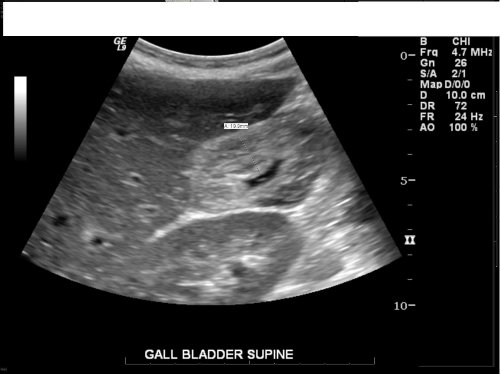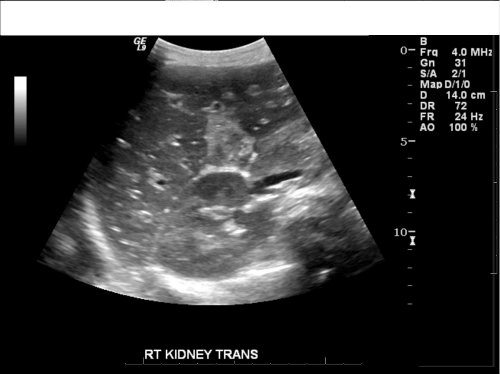Clinical history:
None available.

Which of the following are known causes of gallbladder wall thickening?
- Acute Cholecystitis
- Heart Failure
- Acute Hepatitis
- Hypoproteinemia
- All of the above
Answer: All of the above are possible causes of gallbladder wall thickening 1. The etiology of gallbladder wall thickening can often be elucidated through other imaging findings, history, or laboratories.

What features of the liver are present on this image?
- A. Increased periportal echogenicity.
- B. Dilated intrahepatic bile ducts.
- C. Decreased parenchymal echogenicity.
- D. B and C.
- E. A and C.
Answer: (D) This image shows the classic “starry-sky” appearance of the liver which is traditionally attributed to acute hepatitis. The most common sonographic finding in acute hepatitis is hepatomegaly, with or without starry-sky 2. The starry-sky appearance was first described in 1980 by Kurtz et al as corresponding to edematous swelling of hepatocytes causing decreased echogencity of the parenchyma (sky) as well as better visualization of the fibrous walls of the portal vein (stars) 3. Subsequently, there has been controversy regarding the specificity, sensitivity, and overall clinical utility of the starry-sky appearance for evaluating hepatitis. One series showed the starry-sky was only present in 19 of 791 patients with acute hepatitis, which was not significantly different from a control group of normals4. Additionally, the starry-sky appearance has been described in other conditions including right heart failure, fasting liver, Burkitt’s lymphoma, toxic shock syndrome, and leukemia 5. The common thread between all of these conditions is edematous swelling of the hepatic parenchyma.
Given the above 2 images, what is the most likely cause of GB wall thickening in this patient?
- Gallbladder cancer
- Acute cholecystitis
- Acute hepatitis
- Adenomyomatosis
- Pancreatitis
Given the starry-sky appearance and gallbladder wall thickening- in the absence of gallstones, gallbladder dilatation, or pericholecystic fluid – the most likely etiology is acute hepatitis. The degree of thickening appears to correlate with the severity of hepatocyte necrosis 6. However, the pathophysiological mechanism of gallbladder wall thickening in acute hepatitis remains unclear.
William Astor, M.D.
University of Pittsburgh Medical Center
References:
- Middleton W, Alfred K, Hertzberg B. The Requisities: Ultrasound, second edition. 2004. Mosby.
- Tchelepi H, Ralls P, Radin R, Grant E. Sonography of Diffuse Liver Disease. J Ultrasound Med. 21:1023-1032, 2002
- Kurtz A, et al. Ultrasound Findings in Hepatitis. Radiology 136:717-723, September 1980.
- Giorgio A, Ambroso P, Fico P, et al. Ultrasound evaluation of uncomplicated and complicated acute viral hepatitis. J Clin Ultrasound 1986; 14:675–679.
- Abu-Judeh H. The “Starry-Sky” Liver with Right-Sided Heart Failure. AJR 2002; 178:78.
- Hans-Udo J, Thickening of the Gallbladder Wall in Acute Hepatitis: Ultrasound Demonstration. Radiology 142: 465-466, February 1982.
